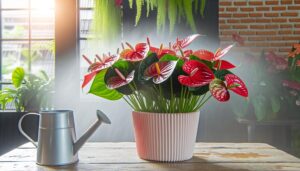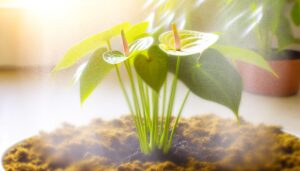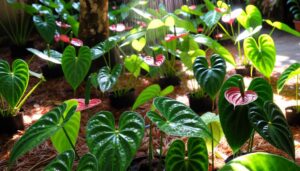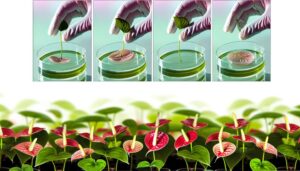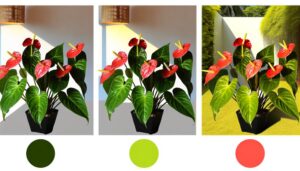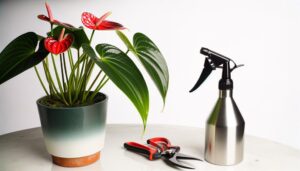Anthurium Soil Mix Tips: 10 Best Suggestions From Reddit
To create the ideal anthurium soil mix, incorporate perlite and coarse sand for superior aeration and drainage. Add orchid bark to enhance nutrient retention and prevent fungal infections.
Sphagnum moss retains moisture without causing root rot. Use charcoal to absorb impurities and improve drainage.
Coconut coir ensures a balance of moisture and aeration. Pine bark adds critical air gaps and prevents waterlogging.
Supplement with worm castings for essential nutrients. Including pumice stones further optimizes drainage.
Avoid using heavy soils that retain excess water. Continue for deep insights and tailored tips to master your anthurium soil mix.
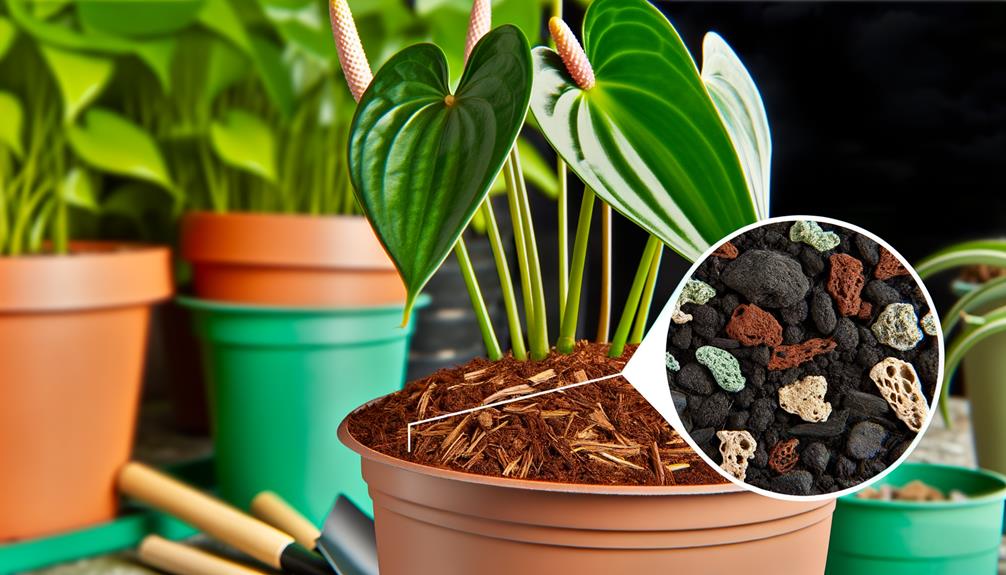
Key Takeaways
- Use a well-draining mix by combining perlite, orchid bark, and coconut coir to prevent waterlogging and promote healthy root growth.
- Include charcoal in your soil mix at a ratio of 1 part charcoal to 4 parts soil to improve drainage and absorb impurities.
- Regularly check soil consistency to ensure it remains well-aerated and free from compaction, which can lead to root rot.
- Add sphagnum moss for moisture retention and aeration, helping to prevent root suffocation while maintaining necessary hydration levels.
- Incorporate pine bark to create air gaps within the soil, promoting effective root respiration and reducing the risk of waterlogged roots.
Choose Well-Draining Soil
When selecting soil for your Anthurium, you'll need to prioritize a mix that offers excellent drainage to prevent root rot and other moisture-related issues. A well-draining soil typically includes components like perlite, which aerates the soil, and coarse sand, which facilitates water movement.
Adding peat moss can help retain some moisture without waterlogging the roots. Avoid heavy, clay-based soils as they retain too much water and lack sufficient aeration. Aim for a loose, chunky texture that allows excess water to flow through easily while still holding enough moisture for the plant's needs.
Regularly check the soil's consistency, as compacted soil can impede drainage and airflow, leading to potential root problems.
Incorporate Orchid Bark
Incorporating orchid bark into your Anthurium soil mix greatly enhances drainage and aeration, vital for healthy root development. Its unique structure also aids in nutrient retention, ensuring your plant receives a steady supply of essential minerals.
Additionally, orchid bark's natural properties help resist fungal infections and deter pests, promoting a robust growing environment.
Drainage and Aeration Benefits
Orchid bark significantly enhances drainage and aeration in anthurium soil mixes, ensuring roots stay healthy and rot-free. By incorporating orchid bark, you're creating air pockets within the soil, which promotes oxygen exchange around the roots.
This improved aeration is crucial because anthuriums are epiphytes, naturally growing on other plants and requiring well-ventilated root zones. The bark also facilitates rapid water drainage, preventing the soil from becoming waterlogged. This is essential in avoiding root rot, a common issue in dense, poorly draining soils.
To achieve optimal results, mix orchid bark with other well-draining components like perlite or pumice. This combination will maintain a balanced moisture level while providing the necessary structural integrity for root development.
Nutrient Retention Properties
Beyond enhancing drainage and aeration, orchid bark plays a significant role in nutrient retention within anthurium soil mixes. The porous structure of orchid bark allows it to absorb and slowly release nutrients, creating a stable nutrient supply for your anthuriums.
This slow-release mechanism prevents nutrient leaching, ensuring that essential elements like nitrogen, phosphorus, and potassium remain available over time. Additionally, the bark's organic composition gradually decomposes, enriching the soil with crucial micronutrients.
Incorporating orchid bark into your soil mix helps maintain a balanced pH level, optimizing nutrient uptake. By using orchid bark, you're not just improving the physical structure of the soil but also enhancing its chemical properties, making it an indispensable component for robust anthurium growth.
Fungal and Pest Resistance
Utilizing orchid bark in your anthurium soil mix can greatly strengthen fungal and pest resistance, thanks to its natural antifungal properties and well-draining nature. Orchid bark creates an inhospitable environment for pathogens and pests by improving aeration and reducing moisture retention. This enhancement is crucial for preventing root rot and fungal infections, common issues with anthuriums.
Consider these benefits:
- Enhanced Aeration: Orchid bark promotes airflow, reducing the chances of fungal growth.
- Moisture Control: Its excellent drainage prevents waterlogging, a key factor in root health.
- Natural Antifungal Properties: The bark's inherent properties deter harmful fungi and pests.
Add Perlite for Aeration
When you add perlite to your anthurium soil mix, you greatly enhance aeration, which is vital for preventing soil compaction and promoting healthy root development.
Perlite's lightweight, porous structure guarantees that oxygen reaches the roots more effectively, reducing the chance of root rot.
This simple amendment can markedly improve the overall health and growth of your anthurium.
Benefits of Perlite Addition
Incorporating perlite into your anthurium soil mix greatly boosts aeration, ensuring the roots receive ideal oxygen levels for healthy growth. Perlite, a lightweight volcanic glass, enhances air pockets within the soil, which is essential for anthuriums that prefer well-draining substrates.
By adding perlite, you allow water to drain more efficiently, preventing waterlogging and root rot while promoting robust root development.
Consider these key benefits:
- Optimal Root Health: Ensuring roots have access to oxygen prevents anaerobic conditions, reducing disease risk.
- Enhanced Drainage: Perlite's porous structure helps water pass through the soil quickly, preventing excess moisture.
- Nutrient Uptake: Better aeration facilitates nutrient absorption, boosting your plant's overall vitality.
Using perlite, you're setting the stage for thriving anthuriums.
Prevents Soil Compaction
How can you guarantee your anthurium roots have the space they need to grow without becoming suffocated by compacted soil? Adding perlite to your soil mix is key.
Perlite, a volcanic glass, improves aeration by creating air pockets. This prevents soil particles from clumping together, reducing compaction.
When you incorporate perlite, aim for a 20-30% ratio in your potting mix. This balance ensures ideal drainage and oxygen flow, essential for anthurium health.
Additionally, perlite is lightweight, which prevents the soil from becoming overly dense under watering. By maintaining this aerated environment, you're allowing your anthurium roots to expand freely, absorb nutrients efficiently, and avoid the stress caused by compacted soil conditions.
Enhances Root Health
Adding perlite to your anthurium soil mix greatly enhances root health by promoting superior aeration and drainage. This lightweight, volcanic glass keeps soil loose, preventing compaction and allowing roots to breathe efficiently. When roots receive ample oxygen, they can absorb nutrients more effectively, fostering robust growth.
Consider these benefits:
- Improved Oxygen Flow: Perlite's porous nature ensures roots don't suffocate, reducing the risk of root rot.
- Efficient Water Management: It helps excess water drain quickly, preventing waterlogged conditions that can harm anthuriums.
- Enhanced Nutrient Uptake: Better aeration from perlite enables roots to access essential nutrients, promoting vibrant foliage and blooms.
Incorporating perlite into your soil mix is a simple yet powerful way to optimize your anthurium's root environment.
Use Sphagnum Moss
Sphagnum moss provides excellent moisture retention and aeration, making it an ideal component for creating a well-draining anthurium soil mix. You'll want to incorporate sphagnum moss to ensure your anthurium's roots get the perfect balance of water and air. The moss's fibrous structure helps prevent root rot by allowing excess moisture to drain away while retaining enough water to keep the roots hydrated.
| Benefit | Description |
|---|---|
| Moisture Retention | Holds water efficiently without becoming waterlogged. |
| Aeration | Promotes air flow, preventing root suffocation. |
| pH Neutral | Maintains a stable pH, avoiding soil acidity issues. |
| Antimicrobial Properties | Reduces the risk of fungal and bacterial infections. |
Mix in Charcoal
Incorporating horticultural charcoal into your anthurium soil mix enhances drainage and helps absorb impurities, keeping the roots healthy and thriving. Charcoal's porous structure allows it to filter toxins and excess moisture, creating an ideal environment for root growth.
To optimize your anthurium's health, follow these steps:
- Mix Proportionately: Add charcoal at a ratio of 1 part charcoal to 4 parts soil mix. This guarantees balanced drainage and impurity absorption.
- Choose the Right Type: Use horticultural-grade charcoal. Avoid using barbecue or activated charcoal, which may contain harmful additives.
- Blend Evenly: Combine charcoal thoroughly with the soil mix. Uniform distribution prevents waterlogging and fosters consistent root development.
Try Coconut Coir
Coconut coir's fibrous texture enhances aeration and moisture retention in your anthurium soil mix, promoting robust root development. This sustainable, pH-neutral medium effectively holds moisture while preventing waterlogging, essential for anthurium health.
You'll find it's an excellent base, combining well with other components like perlite or orchid bark to create a well-draining mix. Remember, coconut coir decomposes slowly, providing long-term structure and stability. Rinse it thoroughly before use to remove excess salts that might accumulate during processing.
Consider Pine Bark
Incorporating pine bark into your Anthurium soil mix greatly enhances drainage, preventing waterlogged roots. This material also promotes robust root health by providing aeration and reducing the risk of root rot.
Additionally, pine bark's slow decomposition contributes to sustained soil structure and nutrient availability.
Ideal Soil Drainage
For the best soil drainage, consider using pine bark as it greatly enhances aeration and prevents waterlogging in anthurium soil mixes. Pine bark offers a coarse texture that creates air gaps within the soil, allowing roots to breathe effectively. It also aids in rapid water passage, preventing water from pooling and causing root rot.
By integrating pine bark, you're ensuring anthuriums receive the perfect balance of moisture and oxygen.
Here's how pine bark benefits your anthurium soil mix:
- Superior Aeration: Promotes healthy root respiration.
- Enhanced Drainage: Minimizes water retention, reducing the risk of root diseases.
- Stable Structure: Maintains soil integrity, preventing compaction over time.
These characteristics make pine bark an excellent choice for ensuring ideal soil drainage in your anthurium mix.
Root Health Benefits
Utilizing the excellent aeration and drainage properties of pine bark directly contributes to robust root health in anthuriums, ensuring ideal growth and resilience against root diseases.
Pine bark's coarse texture promotes air circulation around roots, preventing the anaerobic conditions that often lead to root rot. This material also aids in maintaining a balanced moisture level, essential for avoiding both waterlogged and overly dry environments.
Integrating pine bark into your soil mix can enhance nutrient uptake efficiency due to improved root oxygenation. To maximize benefits, choose medium-sized pine bark pieces, as they offer the perfect balance between aeration and moisture retention.
Regularly inspect and refresh the pine bark to maintain these best conditions for your anthurium's root health.
Add Worm Castings
Adding worm castings to your anthurium soil mix can greatly enhance nutrient availability and improve soil structure. Worm castings, also known as vermicast, are a rich source of essential minerals and beneficial microorganisms. They help improve soil aeration, water retention, and root development.
Here's why you should include them:
- Nutrient-Rich: Worm castings provide a slow-release supply of nitrogen, phosphorus, and potassium, essential for healthy plant growth.
- Microbial Boost: They introduce beneficial bacteria and fungi that break down organic matter, making nutrients more accessible to your anthuriums.
- Improved Soil Structure: The castings create a crumbly texture that enhances soil aeration and drainage, vital for preventing root rot.
Integrate worm castings into your mix for thriving anthuriums!
Include Pumice Stones
Pumice stones play a crucial role in enhancing drainage and aeration in your anthurium soil mix. These lightweight, porous stones prevent soil compaction, allowing roots to access oxygen more efficiently.
You should incorporate pumice at a ratio of about 10-20% of the total soil volume. This ensures optimal moisture retention while facilitating excess water drainage, thereby preventing root rot.
The irregular surface of pumice also promotes beneficial microbial activity, enhancing nutrient uptake. When mixed uniformly with other components, pumice creates a balanced, well-aerated environment ideal for anthuriums.
Avoid Heavy Soils
To guarantee the benefits of pumice are fully realized, you'll need to avoid heavy soils that can impede drainage and aeration, ultimately suffocating anthurium roots. Heavy soils retain too much water, leading to root rot and other fungal issues. Instead, aim for a well-draining mix that promotes healthy root growth.
Consider these key points to evoke a sense of urgency:
- Reduced Oxygen: Heavy soils can create an anaerobic environment that stunts root development and overall plant health.
- Increased Disease Risk: Excess moisture from heavy soils can lead to root rot and fungal infections.
- Poor Nutrient Uptake: Dense soils prevent roots from accessing essential nutrients efficiently.
Conclusion
To sum up, to create the ideal anthurium soil mix, make sure you've included well-draining soil, orchid bark, perlite, sphagnum moss, and charcoal.
Incorporating pine bark, worm castings, and pumice stones will enhance your blend.
Remember, avoid dense soils.
Think of each element as a musician in an orchestra, where equilibrium and concord guarantee your anthurium prospers.
By adhering to these professional suggestions, you'll nurture a setting where your anthurium can thrive.

